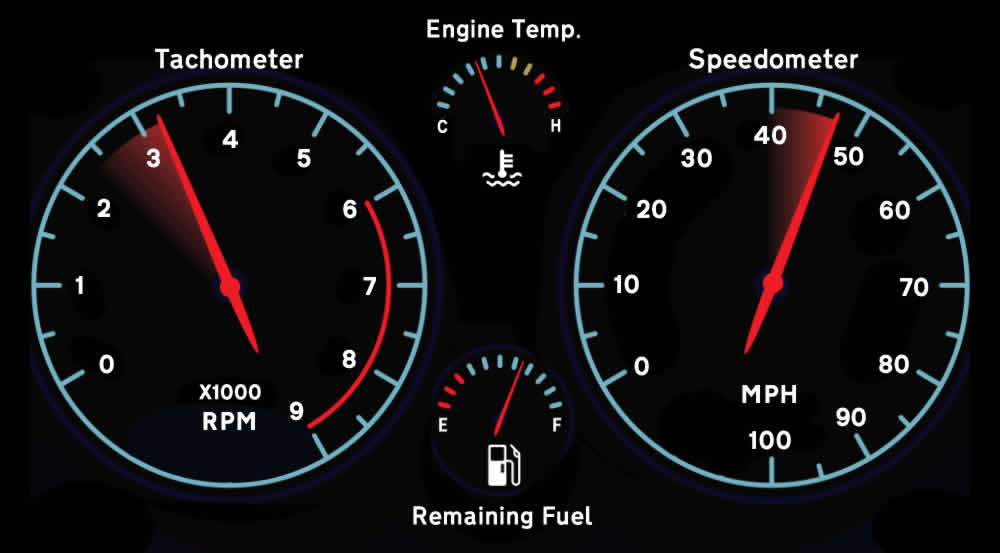As a learner driver, particularly a new learner driver, you’ll need a basic understanding of your car’s gauges on the dashboard. You’ll find that cars all have different dashboard layout designs and varying styles of dials and gauges, but they essentially all mean the same thing.
You may also notice that some cars have analogue dials and gauges. These are the traditional dials that have printed numbers. More modern cars are now fully digital, where an LCD screen displays numbers and gauges, often allowing you to customise what you see. There’s also cars that have a combination of both analogue and digital displays. Again, they all mean the same thing, it’s just that they look different.
Speedometer
As a new learner driver, the most important dial on the dashboard is your speedometer. The speedometer measures the speed at which your car is traveling. As with all the dials and gauges, if it’s analogue you’ll see it when the car’s switched off. If it’s digital, it’ll only appear when the ignition or engine is switched on.
If the speedometer is represented as a dial (see diagram), either digitally or analogue, you’ll see ‘MPH’ within the dial. This stands for miles per hour. Sometimes it may be ‘KM/H’ which is Kilometres per hour, but in the UK we usually go by MPH. If digital, your vehicle’s speed may simply be represented as digital number.
The speedometer is important because you need to be aware of speed limits and that exceeding the limit is illegal. Your instructor will of course help you with speed control when you’re new to driving, but as you progress, it’ll gradually become more of your responsibility.
You should be aware that if you are caught speeding, it’ll be the driver and not the driving instructor (or supervising passenger) who receives the penalty points and fine. So ensure that you know where the speedometer is and that you understand it.
Tachometer
The tachometer, often called the rev-counter measures the engine speed. The tachometer dial is often to the left of the speedometer and has single digits from 0 up to 9 around it. You’ll often see ‘x1000 RPM’ printed on an analogue dial which means each digit is multiplied by 1000.
The ‘RPM’ stands for Revolutions Per Minute and means how many times the engine’s crankshaft makes one full rotation every minute. For example, if you’re driving at 30 mph and the needle on the tachometer is between the 1 and 2, your engine is running at a speed of 1500 revolutions per minute.
You’ll often see a red line on a tachometer. The red line varies on each car and is generally not a concern on automatic cars unless you have manual mode selected. If your engine is running fast enough to be in the red area, slow down or change gear to avoid potential engine damage.
Many automatic cars have a manual mode, where the driver can manually select gears. A tachometer on an automatic car is beneficial in manual mode as it allows you to keep an eye on the engine speed and to change gear before the RPM gets too high. Higher engine speeds use more fuel.
Fuel Gauge
The fuel gauge displays the remaining fuel in the tank. Small cars often have a small fuel tank that contains 30 litres of fuel, which is good for around 300 miles. Larger cars can typically have 60 or more fuel tank capacity. When you have between 30 to 50 miles of driving remaining, the low fuel light will come on.
Engine Temperature Gauge
Your car may or may not have an engine temperature gauge. If a car is well maintained, it’s not a gauge you usually need to pay much attention to. Under normal operation, the temperature gauge needle should remain around the middle of the gauge.
If the needle enters the red area or a red engine warning light comes on, you should reduce speed and stop the vehicle, switching off the engine as soon as safely possible.

Thank you very much to explain these features I gained much
You’re welcome, Amiel.
This is a helpful tool for people who are still attempting to comprehend the significance of the car dashboard, which is explicated in detail in this post.
Thank you so much, because I thought the tachometer was the temperature gauge🤦♂️ 😆